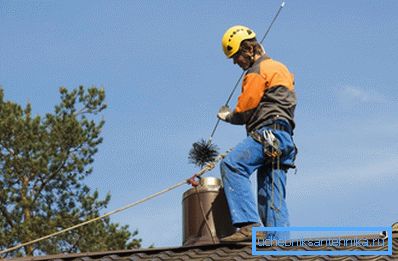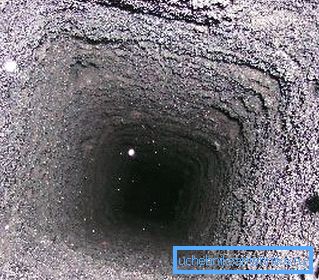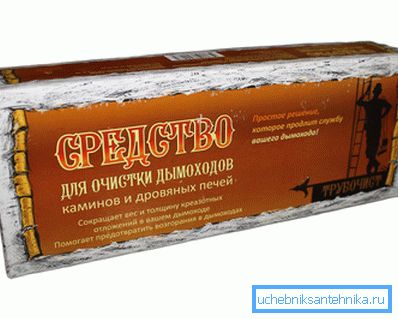Cleaning chimneys: how to restore chimney work
For normal functioning of furnaces and heating boilers in private homes, regular cleaning of chimneys is necessary. It helps to get rid of soot, condensate and other deposits that accumulate on their walls during operation.
The instructions provided in this material will help you carry out all the procedures yourself, saving a significant amount of money.

Problems with pipe operation
Without a properly working chimney, the stove will not work properly. In addition to poor fuel combustion, blockage of the chimneys can cause a fire or carbon monoxide to enter the room.
Troubles can be avoided with regular maintenance of chimneys.
The most common problems are:
- deterioration of chimney draft;
- contamination of the internal space with soot deposits;
- subsidence on the walls of the condensate chimney
- channel blockage with dead bricks;
- leaves from trees;
- cracks that appear on the walls of the chimney (they are especially dangerous in cases where the chimney is indoors, as they often lead to smoke);
- incorrect operation of the chimney due to errors made in its design;
- getting into the chimney remnants of bird nests, which prevents the normal removal of smoke.

Cleaning work can not be postponed until later. Sometimes the cork can be so dense that its removal will require partial dismantling of the chimney.
Varieties of blockages
Most often chimneys may malfunction for the following reasons:
- Soot blockage. Plaque from the products of combustion in the internal space of the chimney is quite natural. The thickness of the layer and the time during which it is formed depends on the material of the structure. The most frequent place of occurrence of soot plugs is the chimney fluff: a brick order has a rough surface, into which soot fragments interfere.

In this regard, installation of stainless steel chimney pipes is more expedient. Their price is not much more, but the smooth surface of the products prevents the accumulation of sediments, which reduces the frequency of maintenance of chimneys.
Tip! Special inserts made of polymers, which are inserted into a ready-made brick pipe, also help protect the structure from soot deposits.
- Condensate. It is a weak acid solution formed on the internal surfaces of the furnaces. Most often, the question of why the chimney is crying is given to people who kindle the firebox only from time to time. With constant use, the liquid, as a rule, has time to evaporate from the flame in the furnace. The formation of condensate depends on the quality of the traction. And in turn, it is influenced by the following factors:
- correct cutting of the chimney on the ceiling (compliance with the dimensions of fuzz, its wall thickness and other parameters);
- the presence in the upper section of the chimney of devices that prevent the creation of reverse thrust in a strong wind (for example, a spark arrester on a chimney);
- sufficient insulation of the chimney in the ceiling (in addition to increasing the thrust and preventing the formation of condensate, it helps protect against fire building structures).
Note! If the chimney passes outside, not inside the house, it must also be insulated. The special attention is demanded by a conclusion of a chimney through a wall. The edges of the structure must not come into contact with brick or concrete. For this it is advisable to use glass wool.
To get rid of moisture in the pipe help special chemicals that are sold in specialized stores. They must be burned in the furnace with fuel once or twice a month.

- Ingestion of foreign objects. This is a very difficult type of blockage that is difficult to remove with your own hands. The chimney can be blocked with bricks that have fallen out of the masonry, a bird's nest or a foreign object.
Tip! To prevent stones, hail, snow or rain will help the head of the chimney.
To clean the chimney in this case will help a small weight, attached to the chain or special tools to hook the load and pull it out.
Preparatory stage
Before proceeding directly to the cleaning, you should visually inspect the flue duct. So, you can visually assess the degree of clogging and decide how the service will be performed.
Inspection can be done in several ways:
- visually from the roof;
- using special video cameras;
- through inspection openings or doors.

Methods for cleaning chimneys
Mechanical
This cleaning method is the most common. It is used when the thickness of soot deposits in the chimney exceeds 3 mm.
The following devices can be used:
- ruff;
- metal brush;
- cable;
- weight;
- flexible rods and shafts.
Most often enough ruff or brush. Otherwise, weights are used that can pierce the resulting plug. If this did not help, you may have to partially dismantle the structure to cope with the problem.

To facilitate the work in various parts of the chimney, it is advisable to provide audit openings or doors through which soot is removed. In addition, the tips of the chimneys must be made removable to facilitate access to the interior space during cleaning.
Work on the removal of soot from the furnace is performed in the following sequence:
- Close the valve that will prevent a cloud of dust and soot from entering the boiler room or room.
- Visually inspect the pipe for the presence of foreign objects in it.
- If there is a small plug or blockage, it can be removed with a stick or load suspended from a rope.
- A pole or weight must be led through the chimney in circular motions, which will allow cleaning the soot layer off the chimney.
- If a large cork is formed, it will be necessary to dismantle a part of the structure.
- At the end of all procedures, the valve should be opened and the rubbish spilled there should be removed from the furnace.

Chemical
This cleaning method is used for the prevention and disposal of small blockages in the pipes formed by soot and condensate.
For this purpose, various substances are used, which are sold in specialized stores. They can be solid, powdered or liquid. In addition to cleaning, chemicals form a protective layer on the walls of the chimney, which protects the pipe from new deposits.

Tip! It is recommended to use chemical cleaning agents regularly. This will ensure the protection of chimneys against the formation of blockages.
The cleaning process is as follows:
- Before starting work, be sure to read the instructions that came with the substance used.
- Fire the stove using any available fuel.
- Once the fire is hot, add the chemical over wood or coal.
If your chosen product comes in the form of solid briquettes, they can be placed in the firebox before you start a fire.

Conclusion
Chimney cleaning is an important and necessary event, without which the normal operation of the furnace or boiler will be impossible. More details about the operation of furnaces and heating systems can be found in the video in this article.